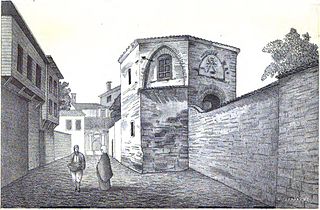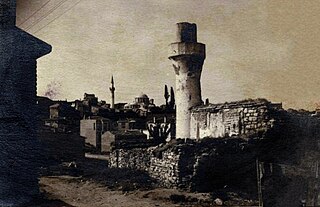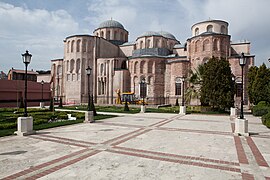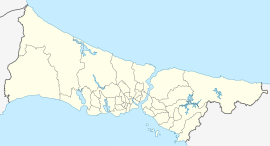
Fatih is a municipality and district of Istanbul Province, Turkey. Its area is 15 km2, and its population is 368,227 (2022). It is home to almost all of the provincial authorities but not the courthouse. It encompasses the historical peninsula, coinciding with old Constantinople. In 2009, the district of Eminönü, which had been a separate municipality located at the tip of the peninsula, was once again remerged into Fatih because of its small population. Fatih is bordered by the Golden Horn to the north and the Sea of Marmara to the south, while the Western border is demarked by the Theodosian wall and the east by the Bosphorus Strait.

The Bayezid II Mosque is an early 16th-century Ottoman imperial mosque located in Beyazıt Square in Istanbul, Turkey, near the ruins of the Forum of Theodosius of ancient Constantinople.

The large Fatih Mosque is an Ottoman mosque off Fevzi Paşa Caddesi in the Fatih district of Istanbul, Turkey. The original mosque was constructed between 1463 and 1470 on the site of the Church of the Holy Apostles. Seriously damaged in the 1766 earthquake, it was rebuilt in 1771 to a different design. It is named after the Ottoman sultan Mehmed the Conqueror, known in Turkish as Fatih Sultan Mehmed, who conquered Constantinople in 1453.

Zeyrek Mosque or the Monastery of the Pantokrator, is a large mosque on the Fazilet Street in the Zeyrek district of Fatih in Istanbul, overlooking the Golden Horn. It is made up of two former Byzantine churches and a chapel joined together and represents the best example of Middle Byzantine architecture in Constantinople. After Hagia Sophia, it is the largest Byzantine religious edifice still standing in Istanbul.

Kalenderhane Mosque is a former Eastern Orthodox church in Istanbul, converted into a mosque by the Ottomans. With high probability the church was originally dedicated to the Theotokos Kyriotissa. The building is sometimes referred to as Kalender Haneh Jamissi and St. Mary Diaconissa. This building represents one among the few extant examples of a Byzantine church with domed Greek cross plan.

Aksaray is a neighbourhood in the municipality and district of Fatih, Istanbul Province, Turkey. Its population is 8,541 (2022). It is so named because it was founded by migrants from Aksaray in central Turkey, brought here in the 15th century by Mehmet II to repopulate the city after its conquest.

The Eski Imaret Mosque is a former Byzantine church converted into a mosque by the Ottomans. The church has traditionally been identified as belonging to the Monastery of Christ Pantepoptes, meaning "Christ the all-seeing". It is the only documented 11th-century church in Istanbul which survives intact, and represents a key monument of middle Byzantine architecture. Despite that, it remains among the least studied buildings in the city.

Koca Mustafa Pasha Mosque is a former Eastern Orthodox church converted into a mosque by the Ottomans, located in Istanbul, Turkey. The church, as the adjoining monastery, was dedicated to Saint Andrew of Crete, and was named Saint Andrew in Krisei or by-the-Judgment. Although heavily transformed during both the Byzantine and the Ottoman eras, it is one of the few extant churches in Istanbul whose foundation goes back to the sixth century.

The AqueductofValens was a Roman aqueduct system built in the late 4th century AD, to supply Constantinople – the capital of the Eastern Roman Empire. Construction of the aqueduct began during the reign of the Roman emperor Constantius II and was completed in 373 by the Emperor Valens. The aqueduct remained in use for many centuries. It was extended and maintained by the Byzantines and the Ottomans.

Vefa is part of the district of Fatih in Istanbul, and lies inside what was once the old walled city of Constantinople. It lies roughly northwest of the eastern section of the Aqueduct of Valens, and is rich in monuments, both Byzantine and Ottoman. It takes its name from the Muslim saint (wali) Shaykh Ebu’l Vefa who is buried locally in his own mosque and dergah.

Şeyh Süleyman Mosque is a mosque in Istanbul converted from a former Byzantine building which was part of the Eastern Orthodox Pantokrator Monastery. Its usage during the Byzantine era is unclear. The small building is a minor example of architecture of the Byzantine middle period in Constantinople.

The Odalar Mosque was an Ottoman mosque in Istanbul. The building was originally a Byzantine-era Eastern Orthodox church of unknown dedication. In 1475, after the Fall of Constantinople (1453), it became a Roman Catholic church, dedicated to Saint Mary of Constantinople, until finally it was converted into a mosque by the Ottomans in 1640. The mosque was destroyed by fire in 1919, and since then has fallen into ruin. As of 2011, only some walls remain, hidden among modern buildings.

Kasım Ağa Mosque is a Byzantine building converted into a mosque by the Ottomans in Istanbul, Turkey. Neither surveying during the last restoration nor medieval sources have made it possible to find a satisfactory answer as to its origin and possible dedication. It is probable that the small building was part of the Byzantine complex and monastery whose main church was the building known in Ottoman era as the Odalar Mosque, whose dedication is also uncertain. The edifice is a minor example of Byzantine architecture in Constantinople.

Ese Kapi Mosque, also "Isa Kapi Mosque", meaning in English "Mosque of the Gate of Jesus", is an Ottoman mosque in Istanbul, Turkey. The building was originally a Byzantine Eastern Orthodox church of unknown dedication.
The Sahn-ı Seman Medrese or Semâniyye was a 15th-century Ottoman medrese (madrasa) complex in Istanbul, Turkey, which was part of the Fatih Mosque. It was one of the highest educational facilities for various sciences such as theology, law, medicine, astronomy, physics and mathematics, and was founded by the astronomer Ali Qushji who was invited by the Ottoman sultan Fatih Sultan Mehmed to his court in Istanbul.

The Cistern of Aetius was an important Byzantine water reservoir in the city of Constantinople. Once one of the largest Byzantine cisterns, it is now a football stadium in Istanbul. Since 1928 it has been known as Karagümrük stadyumu, 'Karagümrük stadium' or Vefa stadyumu, 'Vefa stadium', while in the Ottoman period it was known as the Turkish: Çukurbostan, lit. 'sunken garden'.

The following outline is provided as an overview of and topical guide to Istanbul:

Classical Ottoman architecture is a period in Ottoman architecture generally including the 16th and 17th centuries. The period is most strongly associated with the works of Mimar Sinan, who was Chief Court Architect under three sultans between 1538 and 1588. The start of the period also coincided with the long reign of Suleiman the Magnificent, which is recognized as the apogee of Ottoman political and cultural development, with extensive patronage in art and architecture by the sultan, his family, and his high-ranking officials.

Sekbanbaşı Mosque was a mosque located in the Ottoman capital of Constantinople. It was originally a Byzantine church. According to the writings of Hafiz Hüseyin al-Ayvansarayî (Hadîkatü’l-cevâmi‘), the original Byzantine church had been converted by İbrahim Ağa, the lieutenant of the Ottoman sekban regiments (sekbanbaşı). The building was located in Kendir Sokağı, in the Kırkçeşme quarter, near the ancient aqueduct of Roman Emperor Valens.





















